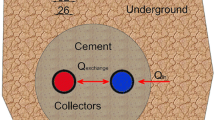Abstract
In shallow geothermal systems, the main equivalent underground thermal properties are commonly calculated with a thermal response test (TRT). This is a borehole heat exchanger production test where the temperature of a heat transfer fluid is recorded over time at constant power heat injection/extraction. The equivalent thermal parameters (thermal conductivity, heat capacity) are simply deduced from temperature data regression analysis that theoretically is a logarithmic function in the time domain, or else a linear function in the log-time domain. By interpreting the recorded temperatures as a regionalized variable whose drift is the regression function, in both cases the formal problem is a linear estimation of the mean. If the autocorrelation function (variogram, covariance) of residuals is known, coefficient variance can be directly deduced. Coefficient estimates are independent of the drift form adopted, and the residuals are the same in the same points. The random function is different in the time domain, however, and in the log-time domain. In fact, residual variograms are different due to the transformation of the coordinate space. This paper uses a TRT case study to examine the consequences of coordinate space transformation for a random function, namely its variogram. The specific question addressed is the choice of coordinate space and variogram.










Similar content being viewed by others
References
Austin WA, Yavuzturk C (2000) Development of an in-situ system and analysis procedure for measuring ground thermal properties. ASHRAE Trans 106(1):365–379
Beier RA, Smith MD (2003) Minimum duration of in-situ tests on vertical boreholes. ASHRAE Trans 109(2):475–486
Boettcher S, Sibani P (2011) Aging in dense colloids as diffusion in the logarithm of time. J Phys Condens Matter 23:065103
Bruno R, Focaccia S, Tinti F (2011) Geostatistical modeling of a shallow geothermal reservoir for air conditioning of buildings. In: Proceeding of IAMG, Salzburg, pp 145–162
Bruno R, Mercuri S, Tinti F, Witte H (2013) Probabilistic approach to TRT analysis: evaluation of groundwater flow effects and machine–borehole interaction. In: Proceedings of European geothermal congress, Pisa, Italy
Chilès JP, Delfiner P (2012) Geostatistics: modeling spatial uncertainty, 2nd edn. Wiley, New York (ISBN: 978-0-470-18315-1)
Dieterich JH (1978) Time-dependent friction and the mechanics of stick-slip. Pageoph 116(4–5):790–806
Edwards N (2005) Marine controlled source electromagnetics: principles, methodologies, future commercial applications. Surv Geophys 26:675–700
Eklof C and Gehlin S (1996) TED–a mobile equipment for thermal response tests. Master’s thesis: 198E, Lulea University of Technology, Sweden
Focaccia S, Bruno R, Tinti F (2013) A software tool for geostatistical analysis of thermal response test data: GA-TRT. Comput Geosci 59:163–170
Gaddum JH (1945) Lognormal distributions. Nature 156:463–466
IGSHPA (2013) Closed-loop/geothermal heat pump systems: design and installation standards. In: International ground source heat pump association. Oklahoma State University, Stillwater
Lloyd CD (2010) Local models for spatial analysis. CRC Press, Taylor & Francis Group, London, p 352 (ISBN: 9781439829196)
Lutkephol H, Xu F (2012) The role of the log transformation in forecasting economic variables. Empir Econ 42:619–638
Marcotte D, Pasquier P (2008) On the estimation of thermal resistance in borehole thermal conductivity test. Renew Energ 33(11):2407–2415
Mogensen P (1983) Fluid to duct wall heat transfer in duct system heat storages. In: Proceedings of the international conference on subsurface heat storage in theory and practice, appendix, Part II, Stockholm
Mouri H (2013) Log-normal distribution from a process that is not multiplicative but is additive. Phys Rev E 88(4). doi:10.1103/PhysRevE.88.042124
Mozyrska D, Torres DFM (2009) The natural logarithm on time scales. JDSGT 7(1):41–48
Sanner B, Hellström G, Spitler J, Gehlin S (2005) Thermal response test–current status and world-wide application. In: Proceedings of world geothermal congress, Antalya, Turkey
Theis CV (1935) The relation between the lowering of the piezometric surface and the rate and duration of discharge of a well using groundwater storage. Trans Am Geophys Union 16(2):519–524
Tinti F, Focaccia S, Bruno R (2015) Thermal response test for shallow geothermal applications: a probabilistic analysis approach. Geotherm Energy 3(6). doi:10.1186/s40517-015-0025-5
Witte HJL, van Gelder GJ, Spitler JD (2002) In situ measurement of ground thermal conductivity: a Dutch perspective. ASHRAE Trans 108(1):263–272
Zhang C, Guo Z, Liu Y, Cong X, Peng D (2014) A review on thermal response test of ground-coupled heat pump systems. Renew Sust Energ Rev 40:851–867
Acknowledgments
The authors sincerely thank Dr. Markus Proell, Ph.D, the ZAE Bayern and all the IEA-ECES Annex 21 group for the invaluable help in understanding thermal response test issues and processes and for giving them the opportunity to work on the Ravensburg TRT dataset, used for the case study. The authors also sincerely thank the reviewers for their encouragement and the useful suggestions that have made this paper much more convincing and complete.
Author information
Authors and Affiliations
Corresponding author
Additional information
The work was presented to GeoEnv 2014 Conference on Geostatistics for Environmental Applications, held in Paris, 9-11/07/2014.
Appendix: Pseudo-variogram Models for the Transformation in the Space of Logarithms
Appendix: Pseudo-variogram Models for the Transformation in the Space of Logarithms
See Appendix Tables 4, 5 and 6. The pseudo-variogram is always included in the standard interval [0, C]. Given a data field of fixed dimension in \({\{}t{\}}\) where the variogram is stationary, the pseudo-range decreases when the field translates towards increasing coordinate values (Fig. 6a). On the contrary, in the case of variogram stationary in \({\{}\tau {\}}\), by keeping the data field of fixed dimension in \({\{}t{\}}\), the pseudo-range increases when the field translates towards increasing coordinate values (Fig. 6b).
Rights and permissions
About this article
Cite this article
Bruno, R., Tinti, F. & Focaccia, S. Estimating Thermal Response Test Coefficients: Choosing Coordinate Space of The Random Function. Math Geosci 48, 3–23 (2016). https://doi.org/10.1007/s11004-015-9612-z
Received:
Accepted:
Published:
Issue Date:
DOI: https://doi.org/10.1007/s11004-015-9612-z




